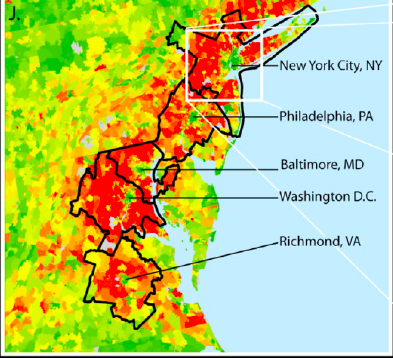A team of scientists this week reopened the debate over suburbs vs. city centers, with new research showing that carbon dioxide emissions increased as suburban areas developed to the southwest of Salt Lake City in the past decade — while comparable population growth in the center of the city did not have the same effect.
It’s the latest evidence highlighting the environmental consequences of suburban expansion, often accompanied by more miles driven by cars and larger free-standing homes that require more energy for heating and cooling. As cities become a central focal point for action on climate change, the ways in which they manage their growth will be a key question.
Yet at the same time, the research itself shows how contentious and complicated this debate is likely to be. The southwestern Salt Lake Valley region in question, for instance, contains a noteworthy community called Daybreak that was itself built around energy-efficient homes and walkability and heralded for its design by the Urban Land Institute — precisely what climate advocates would seem.
“Of course, if you put more people where there weren’t people before, you’re going to have more emissions,” said Christopher Jones, a researcher at the University of California at Berkeley who heads up the CoolClimate Network, which studies the carbon footprints of different U.S. communities, and was not involved in the new study.
“The question is putting them in one type of development, compared with somewhere else.”
The new research was based on the longest-existing network of carbon dioxide sensors in a city and its surroundings. The earliest sensor was established in 2001 at the University of Utah and subsequent sensors were then installed in other parts of the city, the nearby Wasatch mountains (representing a nonurban or “control” environment), and in a rural area to the southwest of the city — which proceeded to show fast population growth.
Emissions growth then followed.
“It’s urban expansion. You’re taking the land surface to a suburban development where there’s cars and houses and some industry, and CO2 emissions go up,” said Logan Mitchell, a postdoc at the University of Utah and lead author of the research that appeared in the Proceedings of the National Academy of Sciences. “In some ways it’s not so surprising, but it’s neat to have measured it and see that response in the atmosphere.”
The research, which was published Monday, was co-authored by 13 other scientists at the University of Utah, the National Center for Atmospheric Research in Boulder, Colo., and several other U.S. universities.
Over the same time period when populations and emissions grew in the southwest part of the Salt Lake valley, the urban center of Salt Lake City also added about 10,000 people. But here, the study found that carbon dioxide emissions — which were already considerably above the levels observed in a nonurban setting — did not grow further in response.
Much of the reason probably has to do with cars, said Mitchell — urban population growth doesn’t necessarily mean more cars on the road, given the fact that people are moving close to the city center, and have public transport, walking and biking options.
Suburban growth also tends to result in larger homes that require more energy to heat, and if that is provided by natural gas burning at the site of the home, then this, too, would lead to more emissions, Mitchell explained. (Cities’ and suburbs’ greenhouse gas emissions do not all occur within their boundaries, since the electricity consumed within those boundaries is often provided by power plants located farther away.)
But Berkeley’s Jones, who was not involved in the study, pointed out that in percentage terms, the population growth in the center of Salt Lake City would be much smaller than the growth in the suburban area, which was previously rural. So he said you would expect to see smaller carbon dioxide changes in the urban core of the city.
The study argues that what happened in Utah may be happening all over the United States — the findings, the authors say, “may be representative of urban transitions in many U.S. cities that have stabilizing emissions in their urban cores, and expanding suburban growth.”
But in this case, the area being studied itself complicates the narrative. The southwestern Salt Lake Valley actually includes at least one newer community that focuses heavily on sustainability and avoiding driving.
The development in question occurred when Kennecott Land, a subsidiary of the mining giant Rio Tinto, built Daybreak, which is about 22 miles from the center of Salt Lake City. It’s a centrally planned community that took environmental and energy-use considerations into account, including preserving walkability and ensuring that the homes would be EnergyStar-certified.
The community advertises the green design of its homes. In fact, a 2014 story in the Salt Lake Tribune noted how the community is actually “built around an intricate master plan with the central, sprawl-busting goal of reducing reliance on driving.”
That’s not to say people don’t drive to work, said Cameron Jackson, the marketing director for Daybreak Communities. “Unfortunately people do have to commute,” he said.
The sensor in question is not located directly in Daybreak. Instead, it measures the air across a broad expanse of the southwest Salt Lake Valley, which would include Daybreak but also a number of other communities.
“I’m not necessarily surprised by the fact that, you know, a study’s been done showing that, 14 years ago, there was very little CO2 here, and now there is,” Jackson said. “Because you add people to a place and that is sort of an automatic outcome. However, our community’s been designed since its very inception to address this very thing.”

You must be logged in to post a comment.